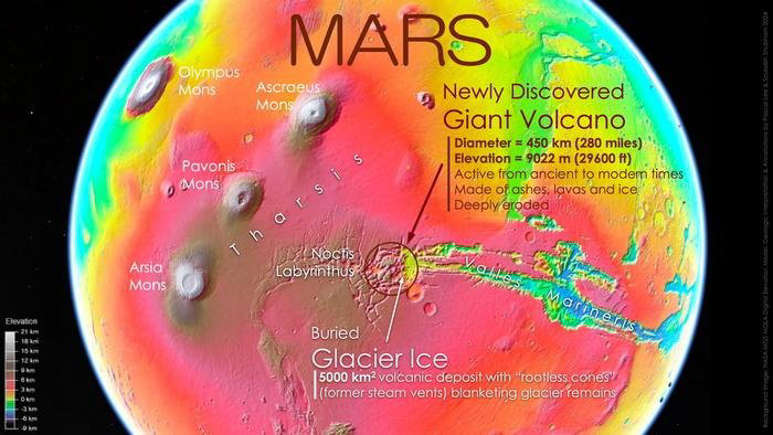New Mars Forums
You are not logged in.
- Topics: Active | Unanswered
Announcement
#1 2016-10-16 23:04:54
- Void
- Member
- Registered: 2011-12-29
- Posts: 9,035
hidden-glaciers-mars
Just trying to do something informational, will not speculate if I can possibly avoid it.
http://www.universetoday.com/131423/hid … ers-mars/#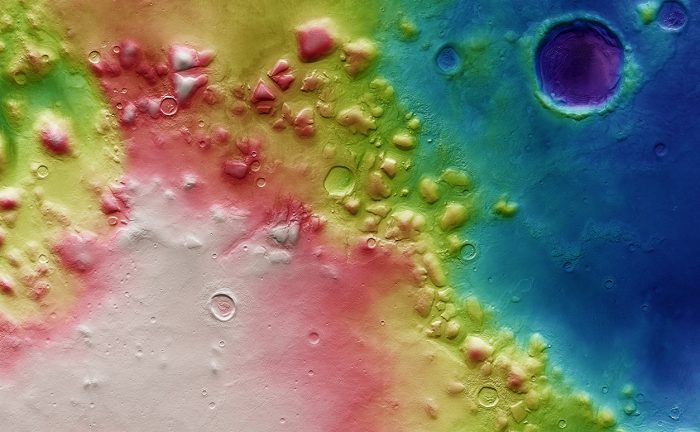
quote:
In the northern hemisphere of Mars, between the planet’s southern highlands and the northern lowlands, is a hilly region known as Colles Nilli. This boundary-marker is a very prominent feature on Mars, as it is several kilometers in height and surrounded by the remains of ancient glaciers.
I would have liked a global map also which pointed out it's location. Is it near the equator?
Another quote from the article:
Combined with this latest info taken from the northern hemisphere, it would appear that there is plenty of ice deposits all across the surface of Mars. The presence (and prevalence) of these icy remnants offer insight into Mars’ geological past, which – like Earth – involved some “ice ages”.
I don't care to speculate on what they intend when they say "plenty of ice deposits all across the surface of Mars".
Maybe someone else has greater information.
Last edited by Void (2016-10-16 23:11:10)
Is it possible that the root of political science claims is to produce white collar jobs for people who paid for an education and do not want a real job?
Offline
Like button can go here
#2 2016-10-17 11:11:07
- Mark Friedenbach
- Member
- From: Mountain View, CA
- Registered: 2003-01-31
- Posts: 325
Re: hidden-glaciers-mars
If you want to talk of glaciers:
http://www.lpi.usra.edu/meetings/lpsc2008/pdf/2441.pdf
Evidence for a 0.28km thick glacier just east of Helles basin.
Offline
Like button can go here
#3 2016-10-17 11:58:55
- Void
- Member
- Registered: 2011-12-29
- Posts: 9,035
Re: hidden-glaciers-mars
That's also a good possibility, if the Hellas basin itself proves to be a good place to operate. 12.4 mb pressure in bottom.
http://m.esa.int/spaceinimages/Images/2 … in_context
https://www.google.com/mars/
Alright, I have no reason to conclude that Colles Nili is at a lower latitude than Hellas. I have been looking, but I have better things to do for now.
Last edited by Void (2016-10-17 12:10:39)
Is it possible that the root of political science claims is to produce white collar jobs for people who paid for an education and do not want a real job?
Offline
Like button can go here
#4 2018-01-30 17:31:45
- phyllistorres
- Banned
- Registered: 2018-01-30
- Posts: 1
Re: hidden-glaciers-mars
This is pretty interesting topic for research. Do you have enough time for it now?
[color=#990000]Hi to everybody [/color]here[color=#990000]![/color]
Offline
Like button can go here
#5 2018-01-30 18:08:10
- SpaceNut
- Administrator
- From: New Hampshire
- Registered: 2004-07-22
- Posts: 29,834
Re: hidden-glaciers-mars
Welcome to NewMars phyllistorres, most of the members here do there own contributions to a topic as we are airchair scientists, rocket engineers and more when it comes to how do we get to mars safely and be able to return with a cargo of mars samples. To which it is hoped that we will begin to spread man kinds wings throughout the universe....
Offline
Like button can go here
#6 2018-01-30 20:42:05
- Void
- Member
- Registered: 2011-12-29
- Posts: 9,035
Re: hidden-glaciers-mars
phyllistorres Hi
http://www.sciencemag.org/news/2017/08/ … fe-seekers
So, maybe there are choices. Water near the equator with a lesser pressure, can I hope for 9 mb in some cases, and water in Hellas. I think that possibly the settlement capabilities might become so much stronger, from what I currently see, that both should be tried.
But I am a different sort of animal. I am not really Scientific, but have some notions of the technological due to my employment histories. Even then I reserve the right to have an interest in the subject matters here. I try not to overstep my limits. But I am sure that on occasion I have made myself an annoyance without understanding the trespass.
Last edited by Void (2018-01-30 20:48:19)
Is it possible that the root of political science claims is to produce white collar jobs for people who paid for an education and do not want a real job?
Offline
Like button can go here
#7 2018-01-31 12:37:38
- Void
- Member
- Registered: 2011-12-29
- Posts: 9,035
Re: hidden-glaciers-mars
The near equator ice is interesting:
http://www.sciencemag.org/news/2017/08/ … fe-seekers
Quote:
Several regions on Mars are potentially water-rich (dark blue), including broad areas near the equator.
J.T. Wilson et al., Icarus (2017)
“This is a really wonderful example of how data, once collected, can be analyzed with new techniques,” says Jim Head, a planetary geologist at Brown University. “When we eventually send people to Mars, we’ll want to go where the water is.”
https://pubs.usgs.gov/imap/i2782/
So, now I think there are three possibilities of how that water could get there.
1) Glaciation from the past.
2) A special condensation process, involving salts and the extreme day night temperature changes.
3) Briny Aquifers. It is now thought that Don Juan pond is fed by a salty aquifer.
https://www.astrobio.net/mars/salty-ant … ars-water/
https://astrobiology.nasa.gov/news/salt … ars-water/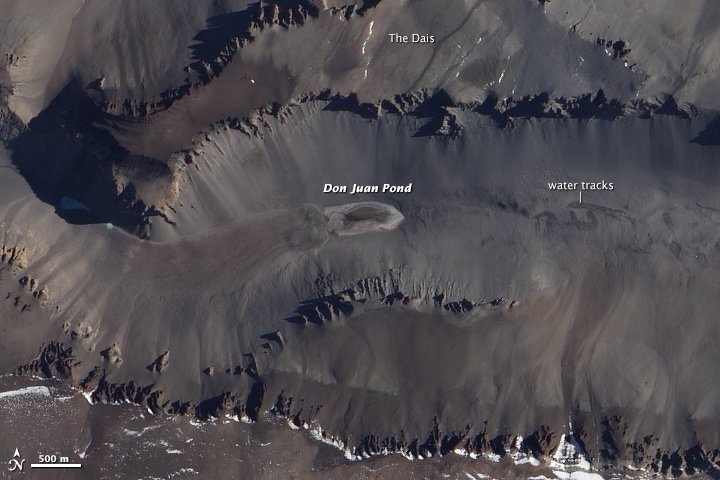
1) Surely some ice deposits discovered, at least at high and mid latitudes must be glacial. But for the equator, it is said they don't know how the ice can survive at the equator for more than 125,000 years.
2) & 3) I was thinking that a condensation process involving salt would deposit ice, but maybe if there are salty aquifers, and a continuous replenishment by such a condensation process, at least some of the moisture is soggy ground with a thin dryer dirt cover.
I am not sure that that can happen, but the articles imply that it might.
For a Mars settlement, a easily accessed briny liquid would be much more usable that ice deposits that need mining.
If you could just suction up liquid (Briny and cold) water, then much less heavy equipment would be required.
Last edited by Void (2018-01-31 13:01:40)
Is it possible that the root of political science claims is to produce white collar jobs for people who paid for an education and do not want a real job?
Offline
Like button can go here
#8 2018-02-02 13:56:28
- Void
- Member
- Registered: 2011-12-29
- Posts: 9,035
Re: hidden-glaciers-mars
I suppose I am a bit off topic, but this thread is dead without it anyway:
https://www.seeker.com/planets/portable … conditions
Notice the phrase "Mineral Crusts" in this next reference:
https://www.sciencedirect.com/science/a … 3512003508
https://www.deepdyve.com/lp/elsevier/mi … SSBKwgwydE
Images:
https://www.bing.com/images/search?q=co … &FORM=IGRE
Yes, I suppose to some extent you are still locked into the 70's or before.
We have two probable examples of very cold spring water (Salty). Don Juan pond at the South Pole:
https://en.wikipedia.org/wiki/Don_Juan_Pond
And Axle Heiberg Island as mentioned previously, at the near north pole.
Both have salty/briny spring water it now seems most likely.
Don Juan pond is probably too hostile for life, but the springs at Axle Heiberg Island do support life.
My own feeling is that Mars has little or no biosphere.
My reason is that in reading an article I was instructed that in searching for life on other planets, one marker which would matter would be the absence of Carbon Monoxide. If it was present, it would indicate that nothing was eating it.
Mars has a small but significant amount of Carbon Monoxide and double that of Oxygen. (Approximately).
I am not that interested in the matter, but it is something to eyeball.
What I am really interested in is the apparent water/ice in specific locations near the equator.
I think that the equator of Mars will be more hostile than Don Juan pond. Not likely to host life. But if there could be life hostile briny springs, with mineral crusts over them and then wind blown dust over that, it is a matter of interest.
1) Well, you want a fluid water to suck up if you can.
2) Don't walk on those mineral crusts and break through!
But, if it is glacial ice, then fine.
It is good that there is water near the equator in any case.
Last edited by Void (2018-02-02 14:11:08)
Is it possible that the root of political science claims is to produce white collar jobs for people who paid for an education and do not want a real job?
Offline
Like button can go here
#9 2021-01-24 20:54:03
- SpaceNut
- Administrator
- From: New Hampshire
- Registered: 2004-07-22
- Posts: 29,834
Re: hidden-glaciers-mars
Apparently another has been found Mystery of Martian glaciers revealed
This image of a glacier on Mars shows the abundance of boulders within the ice. High-resolution imaging of the surface of Mars suggests that debris-covered glacier deposits formed during multiple punctuated episodes of ice accumulation over long timescales. Debris-covered glacial landforms called lobate debris aprons (LDA) are widespread on Mars. It has not been clear whether these LDAs formed over the past 300-800 million years during a single long deposition period or during multiple short-lived episodes of ice accumulation. To address this question, Joseph Levy and colleagues used high-resolution imaging to map boulders along 45 LDAs on the surface of Mars. The boulders are commonly clustered into bands across all LDAs, similar to boulders on ancient terrestrial debris-covered glaciers. The findings point to multiple cycles of ice accumulation and advance over the past 300-800 million years, extending evidence for climate change on Mars beyond the 20-million-year window provided by numerical modeling.
Offline
Like button can go here
#10 2021-06-01 09:32:36
- Mars_B4_Moon
- Member
- Registered: 2006-03-23
- Posts: 9,776
Re: hidden-glaciers-mars
Good news for future Martians!
https://twitter.com/is_OwenLewis/status … 3837795329
Newly discovered glaciers on Mars may help humans settle on the Red Planet one day
Last edited by Mars_B4_Moon (2021-06-01 09:33:23)
Offline
Like button can go here
#11 2022-09-12 07:47:12
- Mars_B4_Moon
- Member
- Registered: 2006-03-23
- Posts: 9,776
Re: hidden-glaciers-mars
Glaciers flowed on ancient Mars, but slowly
Offline
Like button can go here
#12 2022-09-24 14:44:13
- Mars_B4_Moon
- Member
- Registered: 2006-03-23
- Posts: 9,776
Re: hidden-glaciers-mars
The number of Martian lakes might have been underestimated
https://spacepub.org/news/the-number-of … restimated
Geological diversity and microbiological potential of lakes on Mars
Offline
Like button can go here
#13 2023-08-17 18:17:07
- Mars_B4_Moon
- Member
- Registered: 2006-03-23
- Posts: 9,776
Re: hidden-glaciers-mars
This Sure Looks Like the Movements of a Glacier Across Ancient Mars
Offline
Like button can go here
#14 2024-01-30 07:15:17
- Calliban
- Member
- From: Northern England, UK
- Registered: 2019-08-18
- Posts: 4,241
Re: hidden-glaciers-mars
The ESA Mars Express has found a 2-mile thick buried glacier, close to the equator on Mars.
https://www.space.com/mars-water-ice-eq … ozen-ocean
Unfortunately, it appears to be covered in a dust layer hundreds of metres thick. This would complicate accessing the ice. One option would be to drill a well and dump heat into water within the well. Heat will spread out horizontally, melting the ice. The low density dust cover would be an excellent insulator.
Last edited by Calliban (2024-01-30 07:19:04)
"Plan and prepare for every possibility, and you will never act. It is nobler to have courage as we stumble into half the things we fear than to analyse every possible obstacle and begin nothing. Great things are achieved by embracing great dangers."
Offline
Like button can go here
#15 2024-01-30 07:28:17
- tahanson43206
- Moderator
- Registered: 2018-04-27
- Posts: 23,271
Re: hidden-glaciers-mars
For Calliban re #14
Nice find!
Here is a bit about the author of the article...
Keith Cooper
Contributing writer
Keith Cooper is a freelance science journalist and editor in the United Kingdom, and has a degree in physics and astrophysics from the University of Manchester. He's the author of "The Contact Paradox: Challenging Our Assumptions in the Search for Extraterrestrial Intelligence" (Bloomsbury Sigma, 2020) and has written articles on astronomy, space, physics and astrobiology for a multitude of magazines and websites.
It appears to be time for folks who know how to drill to design equipment needed on Mars. The time for Texas Style drilling rigs is at hand.
(th)
Offline
Like button can go here
#16 2024-01-30 09:34:05
- Void
- Member
- Registered: 2011-12-29
- Posts: 9,035
Re: hidden-glaciers-mars
It may be volcanic ash covering the ice. It may be a event of temporary wetness in that area. It may be that the ash is cemented well enough to carve into.
Underground cities in Anatolia: https://en.wikipedia.org/wiki/Derinkuyu … round_city
Images: https://www.bing.com/images/search?q=Un … C3&first=1
The conditions allowing underground cities were the water table was low enough, and the cemented volcanic ash was the right strength to be carved into but strong enough to hold shape.
So, this deposit may be such. Of course you should not then undermine your carved habitat by removing ice under it, but extract your water from an adjacent location.
Done
https://www.bbc.com/travel/article/2022 … 000-people
Image Quote: 
Done
Also, Callibans ideas of cast basalt may apply.
Done
Lots of water at the equator it seems: Quote:
More recently, ESA's Trace Gas Orbiter detected hydrogen from water ice just beneath the surface of Candor Chaos, which is a segment of the immense rip in the surface of Mars that we call Vallis Marineris. Additionally, the remains of ancient glaciers, called relict glaciers, have been spotted in Eastern Noctis Labyrinthus, which is just 7.3 degrees south of the equator.
But if this new one has thick deposits of volcanic ash properly cemented, then you could build massive interconnected vaults and tunnels. Just have to be careful about undermining them by removing ice.
If you could carve blocks of stone to create voids in the rock then perhaps you could build stuff from them as well.
Done
.
Last edited by Void (2024-01-30 09:54:11)
Is it possible that the root of political science claims is to produce white collar jobs for people who paid for an education and do not want a real job?
Offline
Like button can go here
#17 2024-01-30 11:47:18
- tahanson43206
- Moderator
- Registered: 2018-04-27
- Posts: 23,271
Re: hidden-glaciers-mars
For Void re #16
Thank you for that nicely illuminated image of underground, excavated city passageways in Turkey!
When the builders were working on those excavations, they would have only had fossil fuel illumination or none at all.
The tastefully arranged incandescent lights make the space look reasonably livable.
It seems to me that much of Mars is going to look like that, after humans have been there a while, except that illumination may be done with LED lighting rather than incandescent, or perhaps with biological systems which I vaguely recall mentioned elsewhere in the forum archive.
(th)
Offline
Like button can go here
#18 2024-01-31 11:03:38
- Void
- Member
- Registered: 2011-12-29
- Posts: 9,035
Re: hidden-glaciers-mars
The idea of farms in such places becomes more sensible if you offer a strong lowering of the cost of labor. Then the energy collection and transfer become much less costly.
Optimus may be part of that deflation of the cost of hardware: https://www.msn.com/en-us/news/technolo … 8391&ei=14
If plants can be engineered that can also absorb energy though their roots, from chemicals, then it may make even more sense. The acetate trick perhaps.
https://www.snexplores.org/article/inno … ts-in-dark
Quote:
PLANTS
No sun? No prob! A new process might soon grow plants in the dark
Electricity, not light, may one day power their growth — a special boon for space missions
So far Mushrooms, Algae and Yeast work the best, but for Vascular plants perhaps a low level of light combined with the Acetate might work. https://www.nature.com/articles/s43016-022-00530-x
Some selective breeding and genetic engineering might be necessary.
A 10% sunlight and 90% chemical growth method might be fairly pleasant to humans and might be productive.
So, if we can combine water extractions with volcanic ash habitats or maybe sandstone as well, then it might be a good quality of life. I think that there would be glassed in places on the surface also where people could experience sunshine, and maybe see stars.
Various water evidence are showing up on the Martian equator. There may be one that will be easier to start up in somewhere else. There is a water signature in Candor Chaos for instance. https://www.smithsonianmag.com/smart-ne … 180979267/ Quote:
Beneath Canyons on Mars, Astronomers Find Potentially ‘Water-Rich Area the Size of the Netherlands’
A Martian orbiter located a large reserve of hydrogen in a mountainous area of the Red PlanetElizabeth Gamillo
December 20, 2021
Image Quote: :focal(1015x541:1016x542)/https://tf-cmsv2-smithsonianmag-media.s3.amazonaws.com/filer_public/19/14/19146d0f-3e37-4658-a00e-498987ce7760/valles_marineris_pillars.jpg)
That Hydrogen signature is in this rift valley where there are often water fogs. It is near the equator and has a higher air pressure in some of its locations.
The story I am getting about Mars is that on occasion it has a water eruption and then the climate of the planet changes for a little while and raging rivers can run. That probably worked better when the planet was younger and had more geothermal heat.
So there may be other ice bodies, perhaps near rock that is easier to carve.
Done
.
Last edited by Void (2024-01-31 11:19:48)
Is it possible that the root of political science claims is to produce white collar jobs for people who paid for an education and do not want a real job?
Offline
Like button can go here
#19 2024-02-01 11:04:55
- Void
- Member
- Registered: 2011-12-29
- Posts: 9,035
Re: hidden-glaciers-mars
I just thought I would put this video here as supplemental information: https://www.youtube.com/watch?v=ibhEaUWkaP4
Quote:
Enough water to flood Mars! Elon Musk now has a perfect location for his colony!!
The Angry Astronaut
126K
Well, the ice deposit seems to be a big reach to get to, but over time we may figure something out.
As I have said, if the volcanic dust is well cemented, we may dig habitats in it. This even might put the ice in reach. But you would have to be careful not to undermine your habitats.
What we might want to know is how hydrated is the dust layer on top of the ice? If it were enough then you could simply carve in the dust/ash layer and get habitat and water. You would not need to dig all the way down to the ice proper.
They say it is under hundreds of meters of dust. Well, for me that is a little hard to visualize proportion in my head so I converted some numbers to feet.
1000 meters = 3280.8399 feet, so a half mile about. It would depend on if the deposit you were carving habitat in did have ice in its pore spaces.
And eventually you might dig down to the icier areas. I think maybe then you might melt holes down or evaporate holes down and then perhaps fill them with dust from the surface of spoils from the tunnels you might dig in the ash/dust layers.
But how soon you would get to moisture if digging were a question.
Well time flies and I get older, here is something: https://www.extremetech.com/extreme/167 … sity-rover
Quote:
Mars soil contains a huge amount of water, reports NASA's Curiosity rover
If you heat up a cubic foot of Mars soil, you can harvest around two pints (one liter) of water. According to new data returned by NASA's Curiosity rover, this isn't just a one-off lucky find, either: It seems that most of the dirt on Mars harbors large amounts of water. This is very exciting news for future human exploration of Mars, because it's prohibitively difficult to transport water from the surface of Earth to the Red Planet -- and, in one fell swoop, it also makes the eventual terraforming and colonization of Mars a lot more feasible.
By Sebastian Anthony September 27, 2013
Well, from my point of view, this is enough for a growing city. If the dust/ash below the surface is sufficiently cemented, you can just carve it and then dehydrate the spoils. You would not need to dig down to the ice layer itself.
This might not provide enough ice for Starship refilling, but that could be done elsewhere where there is lots of ice but not as good a climate, perhaps.
But with water recycling as may be done on the ISS and the water content of the soil, I would anticipate that this could work.
The big question is can you dig good underground habitats in the dust/ash layer.
https://www.ancient-origins.net/ancient … cia-001394
Image Quote: 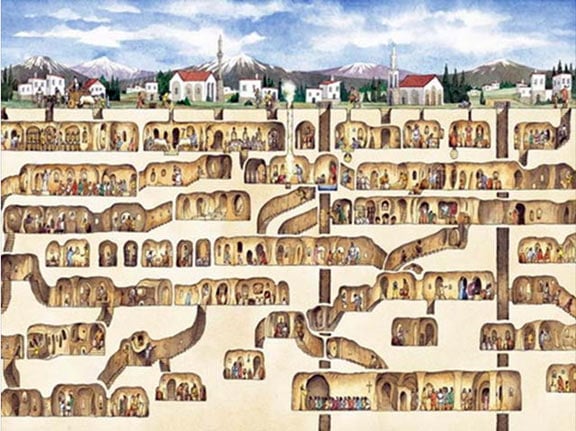
Quote:
A visual depiction of Derinkuyu. Photo credit: Wikimedia
Most people didn’t live in the underground cities full time. Underneath the cities was a vast network of tunnels, connecting each home in the area to the city. When the area came under attack, families would flee to their basements, rush through the dark tunnels, and gather in the underground city.
Unwary soldiers could be caught in the many traps laid throughout the labyrinthine corridors, such as stones which could be rolled to block doorways, and holes in the ceiling through which spears could be dropped. Invaders were further outwitted by the Christian builders who made their tunnels narrow, forcing their enemies to fight, and be picked off, one by one.
Done
Last edited by Void (2024-02-01 11:43:36)
Is it possible that the root of political science claims is to produce white collar jobs for people who paid for an education and do not want a real job?
Offline
Like button can go here
#20 2024-02-02 11:07:21
- Void
- Member
- Registered: 2011-12-29
- Posts: 9,035
Re: hidden-glaciers-mars
Callibans post: http://newmars.com/forums/viewtopic.php … 82#p218882
Includes this link: https://www.space.com/mars-water-ice-eq … ozen-ocean
I have seen report that the quantity of ice could fill the red sea: https://en.wikipedia.org/wiki/Red_Sea
Image Quote: 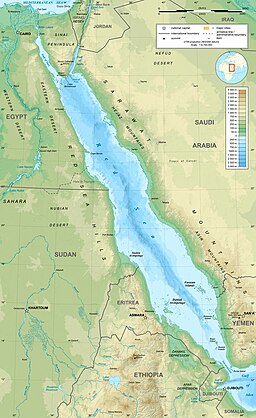
So, over time quite valuable. But also, the ash/dust sediments above it may be of significant value also if it is cemented together well enough to carve habitats in.
I am going to continue this in a terraforming section.
"Index» Terraformation» Worlds, and World Engine type terraform stuff.", Post #1612.
Done
Last edited by Void (2024-02-02 11:19:58)
Is it possible that the root of political science claims is to produce white collar jobs for people who paid for an education and do not want a real job?
Offline
Like button can go here
#21 2024-03-14 18:46:06
- Void
- Member
- Registered: 2011-12-29
- Posts: 9,035
Re: hidden-glaciers-mars
Hard to believe that they think they identified a new volcano on Mars. And that it has hydrated minerals around it and they think it may have a buried glacier at its base. But that is what this article says: https://www.msn.com/en-us/news/world/mo … r-BB1jSylE Quote:
Mount Everest-sized massive Mars volcano with glacier ice at base found
Story by Mrigakshi Dixit • 13h • 3 min read
I think that water in the Tharsis uplift could be important as also lava tubes may be in the area.
Also, with large scale erosion, perhaps minerals like Copper are accessible.
Done
Last edited by Void (2024-03-14 18:49:54)
Is it possible that the root of political science claims is to produce white collar jobs for people who paid for an education and do not want a real job?
Offline
Like button can go here
#22 2024-03-18 09:51:59
- Void
- Member
- Registered: 2011-12-29
- Posts: 9,035
Re: hidden-glaciers-mars
Here is more information on the newly identified Volcano Noctis Mons:
https://www.msn.com/en-us/news/world/hu … 35#image=4
Image Quote:
Even the low areas in the circle might be hard to land in though. But we can hope for lava tubes in the area.
And here is a video: https://www.bing.com/videos/riverview/r … ORM=VRDGAR
Quote:
New Volcano on Mars: Hidden In Plain Sight
YouTube
SpaceExplorationHub
95 views
2 days ago
Done
Last edited by Void (2024-03-18 10:00:10)
Is it possible that the root of political science claims is to produce white collar jobs for people who paid for an education and do not want a real job?
Offline
Like button can go here
#23 2024-03-18 20:33:03
- Void
- Member
- Registered: 2011-12-29
- Posts: 9,035
Re: hidden-glaciers-mars
Here is another video about the new volcano and possible glaciers in the Noctis area: https://www.bing.com/videos/riverview/r … &FORM=VIRE
Quote:
Colossal Discovery: Unveiling Mars' Hidden Volcanic Giant
YouTube
TWiT Tech Podcast Network
395 views
3 days ago
Apparently, there is a good place to land in the zone of it, after all.
Done
Last edited by Void (2024-03-18 20:34:25)
Is it possible that the root of political science claims is to produce white collar jobs for people who paid for an education and do not want a real job?
Offline
Like button can go here
#24 2024-03-26 16:11:51
- Void
- Member
- Registered: 2011-12-29
- Posts: 9,035
Re: hidden-glaciers-mars
Here is more on the newly discovered volcano on Mars: https://www.youtube.com/watch?v=GUwK_kdTLKk
Quote:
NASA discovers huge new volcano on Mars!! And it's a perfect place for Elon Musk's colony!
The Angry Astronaut
132K subscribers
It may have glaciers of ice involved with it.
Done
Last edited by Void (2024-03-26 16:13:48)
Is it possible that the root of political science claims is to produce white collar jobs for people who paid for an education and do not want a real job?
Offline
Like button can go here
#25 2024-06-07 17:57:15
- Mars_B4_Moon
- Member
- Registered: 2006-03-23
- Posts: 9,776
Re: hidden-glaciers-mars
New research finds lake under Mars ice cap unlikely
Offline
Like button can go here
